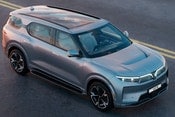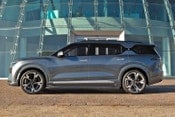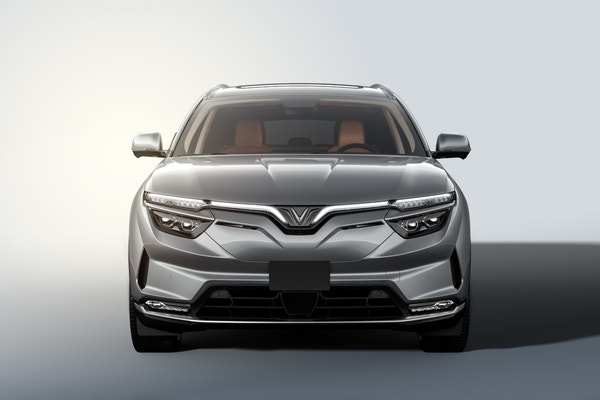After a long, long wait, the 2024 VinFast VF 9 is finally making its way into the hands of customers. To say this process has been a journey would be an understatement, akin to calling The Odyssey a short cruise.
I was hopeful that perhaps the extra time meant the VF 9's rollout could go smoother than that of the VF 8, which we found to have various build quality and drivability issues. And while my total drive time in the VF 9 was very, very brief, I'm still confident that a few bugs need to be worked out before this SUV is truly ready for prime time.
What is the VinFast VF 9?
The VF 9 is a larger and more expensive follow-up to the VF 8. It is a three-row SUV, similar in size to the Kia EV9 and Rivian R1S (at least on the outside), though it's a good deal shorter in height than those vehicles. Both the Eco and Plus trims come with a dual-motor powertrain that makes 402 horsepower and 457 lb-ft of torque, enough to hustle the VF 9 from 0 to 60 mph in a VinFast-estimated 6.6 seconds (Eco) or 6.7 seconds (Plus). The VF 9's range estimates far outpace the VF 8's 264 miles of maximum range, with the Eco offering an estimated 330 miles and the Plus 290 miles — the difference is likely thanks to the smaller wheels on the Eco. The VF 9's second row is only offered as a bench seat in the Eco, putting seating capacity at seven, while the Plus is available with power captain's chairs for backseat riders.
How does the VF 9 drive?
Before I even set off on my test drive, several error messages popped up on the VF 9's central screen. The first indicated that the anti-pinch system in the windows was malfunctioning, and as a result, my passenger's window would not close. After that, the car flashed a few more warnings quicker than I could note their contents, and then the VF 9 refused to go into drive due to a fault with a door sensor. A quick look at the virtual diagram of the VF 9 didn't indicate which door was causing the issue, but opening and closing three of them seemingly solved this problem and the vehicle finally went into drive. I should also note that, while this was happening, another journalist reported their VF 9 showed a tailgate malfunction warning.
My total drive loop was a short 3.1 miles through heavy traffic and only on city streets, but in that time there were no glaring issues with the VF 9's driving experience. It seemed to ride better than the VF 8 thanks to that longer wheelbase, and the acceleration and braking were smooth, with the regenerative braking coming on without too much fuss. I got to do one quick launch off from a stoplight and the VF 9 had plenty of kick. Obviously, I'll need significantly more time behind the wheel of a VF 9 to give it a proper shakedown, but, at least in this brief experience, the VF 9 seemed more dialed in than the VF 8.
How's the VF 9's interior?
Much like a Tesla, the VF 9 eschews an instrument cluster and most buttons, though thankfully, traditional stalks remain for the turn signals and wipers. The 15.6-inch central screen is where you'll look to find all of your info. The screen in my test SUV was responsive, and I was pleased to note that wireless Android Auto and Apple CarPlay are standard, to give users some functionality that Rivian and Tesla lack. I was also able to quickly find the controls to adjust the mirrors and steering wheel, and it was reasonably intuitive.
The quality of materials in my test car appeared decent at first glance, but I should note that my drive also took place after dark so it was hard to get a good look at the overall build quality of the vehicle. That said, I didn't notice any overt squeaks or rattles from behind the wheel, or while sitting in the third row on the way back.
Charging capability for devices is a mixed bag. There's a wireless charging pad and USB-C ports up front, but once you get to the second row there are weirdly two USB-A ports (along with one USB-C port), and in the third row all you get is a pair of USB-As. However, I did note that the USB-C port in the second row was labeled with a small icon that said "90 Watts," and that's interesting because, even if that power supply is shared between all of the ports, that's enough juice to charge a MacBook Pro.
Interior room in the first two rows was great and the front massaging seats were good. However, the third row was disappointing in terms of both room and access. In the Plus version, the captain's chairs can move and tilt forward, but that doesn't give you enough space to access the third row. To get back there, you must fold the seatback down and climb over it to reach the third row. And you can't jimmy yourself between the captain's chairs because there's a large armrest in the way. Once you clamber back into the third row, you'll find a surprising amount of headroom, but the floor is unsettlingly close to the seat bottom. Sitting in the very back will there a tough proposition, even for children. Both the EV9 and R1S offer significantly more room for passengers and cargo alike.
Incomplete grading
I will need to spend more time with the VF 9 to give fully fleshed-out thoughts on its potential, but the initial showing did not do much to assuage our concerns based our experience with the VinFast VF 8. Being met with error messages when you hop into the driver's seat for the first time leaves a sour taste in your mouth.
This is compounded by the VF 9's pricing. The more expensive Plus model is the only version available now, and it starts at $75,000 (including a $1,200 destination charge) without options like metallic paint or captain's chairs. That puts it within spitting distance of a fully loaded Kia EV9, an electric SUV that feels light-years ahead in terms of interior refinement, software and general usability.








